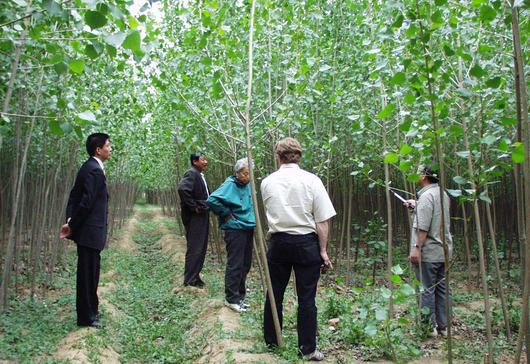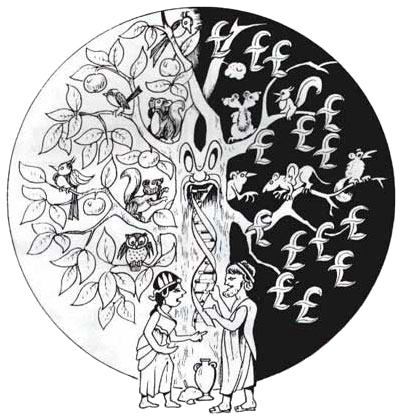- Details
- Hits: 3070
Why there should be a moratorium on GM trees
The threat of GM trees recognised
 The Convention on Biological Diversity's (CBD) passed a formal declaration at its Eighth Conference of the Parties (COP-8) in Curitiba, Brazil on 31 March 2006 to recognize the threats posed by genetically modified (GM) (same as genetically engineered (GE) trees, and urging all countries to approach the technology with caution [1].
The Convention on Biological Diversity's (CBD) passed a formal declaration at its Eighth Conference of the Parties (COP-8) in Curitiba, Brazil on 31 March 2006 to recognize the threats posed by genetically modified (GM) (same as genetically engineered (GE) trees, and urging all countries to approach the technology with caution [1].
This important declaration came in support of the Food and Agriculture Organisation (FAO) call for an international framework to assess the safety of GM trees in 2005 [2]. Many groups are hoping that the UN involvement will finally address the environmental and socio-economic impact of GM trees on global forest diversity, and on local and indigenous communities.
Pierre Sigaud, FAO expert in forest genetics, warned against rushing to commercialise GM trees before conducting environmental risk assessments in accordance with national and international biosafety protocols. He said, “The issue goes beyond country level since pollen flow and seed dispersal do not take account of national boundaries and wood is a global commodity.” To counteract the contamination of native stands by GM trees, a robust framework to govern research and application is essential, Sigaud added.
Moratorium backed by developing countries
The increasing use of biotechnology in the forestry sector has led to the spread of GM tree planting in at least thirty-five countries. According to the FAO, most research is confined to the laboratories, but many millions of GM trees have already been released in open field trials in China, North America, Australia, Europe, and India , and to a lesser extent, South America and Africa [3].
Nine developing countries supported calls for a moratorium on G M trees proposed by government representatives of Iran and Ghana [4 ]. Among these countries are Ecuador, Egypt, Philippines, Rwanda, Senegal and Madagascar, and Malawi, some of whom are home to the richest, most biodiverse forests on Earth. The motion was opposed only by Canada and Australia, both governments having vested interests in biotechnology. But they too agreed that a detailed investigation into the impact of GM trees is needed.
- Details
- Hits: 2972
A resounding "No" to GMOs.
 The response to GM crops in the UK's GM Nation? public debate is an overwhelming "No." A total of 36,557 people returned the questionnaire accompanying the debate. The vote is one of the largest ever to be returned by the public. The results are as follows:
The response to GM crops in the UK's GM Nation? public debate is an overwhelming "No." A total of 36,557 people returned the questionnaire accompanying the debate. The vote is one of the largest ever to be returned by the public. The results are as follows:
- 54% of respondents said they never want to see GM crops grown in the UK
- 18% said they would only find GM crops acceptable if there were no risk of cross-contamination
- 13% requested more research before government decisions are made
- 2% said GM crops were acceptable in any circumstances.
When asked if they were happy to eat GM food:
- 86% were not happy to eat GM food
- 8% were happy to eat GM food
- 6% were undecided.
The GM Nation? organisers also conducted a sub-survey of members of the general public who didn't take part in the debate to see how different their views on GM were. They found a consensus on seven key points:
- People are generally uneasy about GM
- The more people engage in GM issues, the more their attitudes harden against the technology
- There is little support for early commercialisation
- There is widespread mistrust of government and multinational corporations
- There is a broad desire to know more and for more research to be done
- Developing countries have special interests
- The debate was welcomed and valued.
This latest poll confirms that the public is as hostile as ever towards GM. But the government may still push ahead with commercialisation of the crops because UK ministers are keen to avoid upsetting EU-US relations. Trade secretary Patricia Hewitt is mindful of the recent US-launched legal action against the EU under World Trade Organisation rules.
- Details
- Hits: 3036
GM poplars released and unregulated are hard to trace, GM trees are a potential ecological disaster and should be banned
One million GM trees
 Fifty years of relentless development has forced China’s forests into retreat. Inevitable environmental consequences such as desertification and flash floods have resulted in China becoming a net importer of wood. The Great Green Wall project (2001) sponsored by the Government aims at planting a 2800-mile long shelterbelt of trees across the northwest rim skirting the Gobi desert. This is intended to combat sandstorms blowing closer to Beijing, at a cost of 96.2b yen.
Fifty years of relentless development has forced China’s forests into retreat. Inevitable environmental consequences such as desertification and flash floods have resulted in China becoming a net importer of wood. The Great Green Wall project (2001) sponsored by the Government aims at planting a 2800-mile long shelterbelt of trees across the northwest rim skirting the Gobi desert. This is intended to combat sandstorms blowing closer to Beijing, at a cost of 96.2b yen.
Over one million GM trees have been planted in "reforestation" initiatives since commercialisation was approved by The Chinese State Forestry Administration in 2002. In the northwest regions of Xinjiang province 8 000 square kilometres of farmlands are given over to GM tree mono-plantations. A further 400 000 GM poplars planted around the headlands of the Yellow and Yangtze Rivers continue to be plagued by insect pests although they are engineered to be pest resistant. GM trees introduced into the environment without any proper controls have subsequently been "lost" to monitoring.
Wang Huoron from the Chinese Academy of Sciences told the UN Food and Agriculture Organisation (FAO) in 2003 that the GM poplars "are so widely planted in China that pollen and seed dispersal cannot be prevented." He also reported to the FAO that without any licensing system and exchanges between nurseries of traditional and GM plant varieties has made it "extremely difficult to trace" the location of GM trees.
- Details
- Hits: 2977
Sam Burcher reports on a global movement to ban GM trees.
 Some 400 GM birch trees (Betula pendula) in a single GM field study situated in Punkaharju, Finland have been either ripped up or cut down by unknown parties at an estimated cost of 1.21 million euros in June 2004.
Some 400 GM birch trees (Betula pendula) in a single GM field study situated in Punkaharju, Finland have been either ripped up or cut down by unknown parties at an estimated cost of 1.21 million euros in June 2004.
After the attack, the researchers at the Finnish Forest Research claimed that their purpose was to examine the environmental risks of horizontal gene transfer. When they originally applied for permission for the field trial in 2000, however, it was to study the carbon-nitrogen processes of GM trees.
Protests against GM trees greeted the 4th UN Forum on Forests (UNFF) in Geneva in May 2004, because of the “Decision” to draft plans for GM tree projects made at the UN Framework Convention on Climate Change (COP9) in Milan in December 2003.
GM trees have been included in the Kyoto Protocol as a means of generating carbon credits under the Clean Development Mechanism. Carbon credits sold in this way are not subject to the traceability legislation that applies to all other GM imports into Europe and therefore countries hosting GM trees will have no way of knowing whether their credits are GM free or not.








